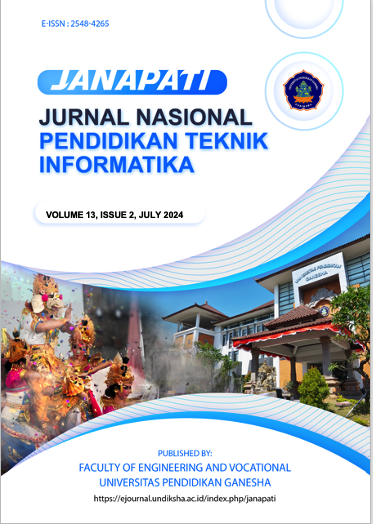Comparative Analysis of CNN Methods for Periapical Radiograph Classification
DOI:
https://doi.org/10.23887/janapati.v13i2.71664Keywords:
Periapical radiographs, Convolutional Neural Network (CNN), Primary Endodontic Lesion, F1-Score, Precision, EfficientNetB1, ResNet50v2, MobileNetAbstract
Periapical radiographs are commonly used by dentists to diagnose dental problems and overall dental health conditions. The varying abilities of dentists to diagnose may be limited by their visual acuity and individual skills. To address this issue, there is a need for an application capable of computationally recognizing and classifying periapical radiographs. The commonly used computational method for image processing, specifically image recognition, is the Convolutional Neural Network (CNN) method. This study aims to create an application that can classify periapical radiographs and analyze the capabilities of the Convolutional Neural Network (CNN) method in this classification process. In general, periapical classification is divided into five types: Primary Endo with Secondary Perio, Primary Endodontic Lesion, Primary Perio with Secondary Endo, Primary Periodontal Lesion, and True Combined Lesions. The periapical radiograph classification process was tested using four CNN models: ResNet50v2, EfficientNetB1, MobileNet, and Shalow CNN. The evaluation of the CNN method utilized a confusion matrix-based technique to generate accuracy, precision, recall, F1-score and Weighted Average F1-score values. Based on the evaluation results, the highest accuracy value was achieved by EfficientNetB1 with 82%, followed by ResNet50v2 with 76%, MobileNet with 75%, and Shallow CNN with 71%.
References
R. Ismail Hardianzah, B. Hidayat, F. Teknik Elektro, And U. Telkom Jl Telekomunikasi Terusan Buah Batu Bandung, “Pengolahan Citra Radiograf Periapikal Pada Deteksi Penyakit Pulpitis Menggunakan Metode Adaptive Region Growing Approach,” 2017.
M. Louisa, “Lesi Endoperio 1,” 2015.
B. Indra And S. Huldani, “Radiografi Gigi Dan Imunitas Serluler Trombosit Hemoglobin Leukosit”,2019.
C. W. Li Et Al., “Detection Of Dental Apical Lesions Using Cnns On Periapical Radiograph,” Sensors, Vol. 21, No. 21, Nov. 2021, Doi: 10.3390/S21217049.
S. M. R And M. Tech Student, “Classification Of Dental Disease Using Cnn,” 2020. [Online]. Available: Http://Ijesc.Org/
University Of Buner. Department Of Electronics & Computer Science And Institute Of Electrical And Electronics Engineers, 1st International Conference On Electrical, Communication And Computer Engineering (Icecce 2019) : 24th - 25th July 2019, Swat, Pakistan.
A. Thomas, R. N. Firman, And A. Azhari, “Analisis Radiograf Periapikal Menggunakan Software Imagej Pada Granuloma Periapikal Pada Perawatan Endodontik,” Majalah Kedokteran Gigi Indonesia, Vol. 3, No. 2, P. 105, Dec. 2017, Doi: 10.22146/Majkedgiind.10472.
M. Tan And Q. V Le, “Efficientnet: Rethinking Model Scaling For Convolutional Neural Networks”,2019.
Fangyuan Lei, Xun Liu, Jianjian Jiang, Qingyun Dai, Hongyu Liu, Mengying Hu.” Shallow Convolutional Neural Network for Image Recognition”,2019.Doi: 10.17706/ijcee.2019.11.4.192-197
Agung Wahyu Setiawan.” Comparison Of Convolutional Neural Network Architecture In The Classification Of Pneumonia, Covid-19, Lung Opacity, And Normal Using Thorax X-Ray Image”,2022. DOI: 10.25126/jtiik.202296742.
Made Windu Antara Kesiman; Kadek Teguh Dermawan; I Gede Mahendra Darmawiguna. “Balinese Carving Ornaments Classification Using InceptionResnetV2 Architecture”,2023. DOI:10.1109/CENIM56801.2022.10037265.
Yuni Naomi Yenusi, Suryasatriya Trihandaru, Adi Setiawan.” Perbandingan Model Convolutional Neural Network pada Klasifikasi Wajah Orang Papua dan Etnis Lainnya”,2022. https://doi.org/10.23887/jstundiksha.v12i1.46861
Zhafeni Arif, R. Yunendah Nur Fu’adah, Syamsul Rizal, Divo Ilhamdi. “Classification of eye diseases in fundus images using convolutional neural network (CNN) method with efficientnet architecture”,2023.DOI: http://dx.doi.org/10.29210/02020344.
Ching-Chen Wang, Ching-Te Chiu, Jheng-Yi Chang. “EfficientNet-eLite: Extremely Lightweight and Efficient CNN Models for Edge Devices by Network Candidate Search”,2020. DOI:https://doi.org/10.48550/arXiv.2009.07409
Abdul Rafay a, Waqar Hussain. “EfficientSkinDis: An EfficientNet-based classification model for a large manually curated dataset of 31 skin diseases”,2023. DOI: https://doi.org/10.1016/j.bspc.2023.104869.
Downloads
Published
How to Cite
Issue
Section
License
Copyright (c) 2024 Windu Antara, Gede Sunarya, Lanang Trisna

This work is licensed under a Creative Commons Attribution-ShareAlike 4.0 International License.
Authors who publish with Janapati agree to the following terms:- Authors retain copyright and grant the journal the right of first publication with the work simultaneously licensed under a Creative Commons Attribution License (CC BY-SA 4.0) that allows others to share the work with an acknowledgment of the work's authorship and initial publication in this journal
- Authors are able to enter into separate, additional contractual arrangements for the non-exclusive distribution of the journal's published version of the work (e.g., post it to an institutional repository or publish it in a book), with an acknowledgment of its initial publication in this journal.
- Authors are permitted and encouraged to post their work online (e.g., in institutional repositories or on their website) prior to and during the submission process, as it can lead to productive exchanges, as well as earlier and greater citation of published work. (See The Effect of Open Access)







